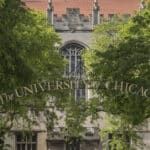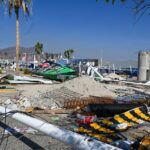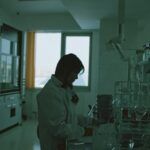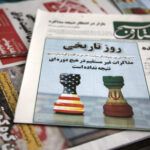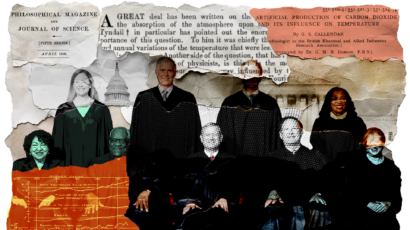The lasting toll of Semipalatinsk’s nuclear testing
By Togzhan Kassenova | September 28, 2009
During the rainy, windy early morning of August 29, 1949, the Soviet Union conducted its first nuclear explosion–code-named “First Lightning”–at the Semipalatinsk Test Site in eastern Kazakhstan. Witnesses remember feeling the ground tremble and seeing the sky turn red–and how that red sky was quickly dominated by a peculiar mushroom-shaped cloud. The Soviet military and scientific personnel conducting the test knew that the rain and wind would make the local population more susceptible to radioactive fallout. But at the time, authorities disregarded the consequences for the sake of military and political goals. Throughout the next 40 years, such a trade-off would become all too familiar to those living at and around the test site. In all, the Soviet Union conducted 456 nuclear tests at Semipalatinsk (340 underground and 116 aboveground), starting with that first one in August 1949 and ending with the final test on October 19, 1989. In 1991, Kazakhstan’s President Nursultan Nazarbayev officially closed the site and ordered that medical help and compensation be provided to those suffering from illness due to testing.
During the first decades of testing, the Soviet military built a secret research and administrative center 60 kilometers away from the testing grounds–a new town that the outside world would come to know only as Semipalatinsk-21. Given its secret mission, Semipalatinsk-21 was never identified on any official maps. As such, it was surrounded by barbed wire, and the flow of people in and out of the town was strictly controlled. Later, the town would be renamed Kurchatov, after the man who helped the Soviet Union obtain the bomb. The largest civilian town, Semipalatinsk, was located 160 kilometers away; while a few rural settlements were scattered nearby the site.
Although it has been 20 years since the last nuclear weapon was exploded in Kazakhstan, its people still have vivid memories of the Soviet testing era–memories that they kindly shared with me during a three-week trip I took there in July. Take, for instance, Gulsum Kakimzhanova, the head of the nongovernmental organization Iris, which is based in Semipalatinsk and helps those affected by the testing find the proper medical and social care. (During one project, Iris arranged breast cancer screenings for more than 18,000 women who live in areas close to the former test site.) Kakimzhanova herself was born in 1952 at a railway settlement not far from Semipalatinsk. The effects of the tests were everywhere. “One morning when I was a small girl, my father awoke to find all of his hair had fallen off onto his pillow overnight,” she told me. “Only many years later, when I began working on health issues as a trained biologist, did I realize that my father’s hair loss was likely caused by radiation exposure while he labored outside as a railway worker near the test site.”
Natalya Zhdanova, who lived in Kurchatov from 1968 to 2000, remembers that announcements about the tests were broadcast on the local radio stations, along with movie show times and weather forecasts. As a member of a military family whose relatives were involved in the testing, she never worried about how the tests might impact her or her family’s health. In fact, it was apparent when I spoke with her that she viewed the military presence in Semipalatinsk patriotically: “People were not afraid of radiation–maybe because nobody was suffering from leukemia or other diseases. Our fathers and husbands worked in this field, and they never had any health problems, apart from the great responsibility that came with the task. And everyone always followed safety procedures.
“I always give an example of a family I know personally–a military tailor who came with his family to Kurchatov back at the time of testing. He still lives in Kurchatov today and so do his sons, grandsons, and great-grandsons. They are all absolutely healthy, not bald, not sick with leukemia, cancer, or thyroid disease. Four healthy generations!”
Years of radioactive fallout. The actual extent of damage inflicted by nuclear testing at Semipalatinsk continues to be the subject of much research and debate. A 2008 study by Kazakh and Japanese doctors noted that the population in Semipalatinsk and other areas adjacent to the test site received more than 500 millisieverts of radiation in one exposure.1 In one village, which was engulfed by a radioactive cloud after that first nuclear test in August 1949, 90 percent of its inhabitants received an external effective dose of up to 1,400 millisieverts during the first year alone. (See “Radiological Situation in the Vicinity of Semipalatinsk Nuclear Test Site”.) In the most heavily contaminated areas, people received an estimated effective equivalent dose of 2,000 millisieverts during the years of testing. (See “The Semipalatinsk Nuclear Test Site: A First Analysis of Solid Cancer Incidence [Selected Sites] Due to Test-Related Radiation”.) At the very least, a majority of the 220,000 affected people were exposed to an estimated dose of between 7 millisieverts and 350 millisieverts, and about 37,200 residents were exposed to radiation doses between 350 and 990 millisieverts during the period of atmospheric testing. (In terms of actual health effects, the Kazakh and Japanese scientists noted that the rate of cancer in those living in eastern Kazakhstan, the area most exposed to radiation, remains 25-30 percent higher than elsewhere in the country; they also reported a higher chance of mental deficiencies in children born to parents who were exposed to radioactive fallout from testing.)2
To put these exposure numbers in perspective, the average American is exposed to about 3 millisieverts of background radiation each year. (See “Health Risks from Exposure to Low Levels of Ionizing Radiation”.) And typically, people who receive an equivalent external dose of 500-1,000 millisieverts develop problems with blood-forming processes (i.e., reduced red and white blood counts). Among those exposed to an equivalent external dose of 3,000-5,000 millisieverts, one-half die within two months. A key fatality factor among people with radiation sickness is the effect on bone marrow, which results in a rapid decrease in white blood cells.
In 1957, the military built the Anti-Brucellosis Dispensary No. 4, purportedly to monitor tuberculosis infections in the area. In reality, though, the facility was built to secretly observe the impacts of radiation exposure from nuclear testing on local people. Today, bitterly, locals note that they were nothing more than “guinea pigs” in a grandiose experiment.
Although detailed information about the health impacts of Soviet nuclear testing were classified, between 1957 and 1960 Kazakh doctors were allowed to undertake a clinical examination of those living near the site. Their findings were in stark contrast to those of doctors associated with the military complex. While the doctors dispatched by the Soviet military blamed environmental factors and poverty for the poor health of local residents, the Kazakh doctors found a direct correlation between illness and radiation exposure, according to Dr. Bahiya Atchabarov who led the study and was interviewed years later in Kazakhstanskaya Pravda. In particular, the Kazakh team recorded hemorrhaging of respiratory tracts, mouths, genitals, and changes in mucous and skin of those living in the area surrounding the test site. They also noticed a spike in those suffering from asthenia, or extreme fatigue. More often than not, victims would suffer from all of these symptoms at once. The study’s findings filled 12 volumes of classified documents. Only after the Soviet collapse did this research become available to the general public.
Eventually, the team was forced by Soviet authorities to stop their clinical studies. The nuclear testing, however, continued, with statistics on cancer and mortality rates in the Semipalatinsk area remaining classified.
Lifting the veil of secrecy. Democratization and other reforms that began in the Soviet Union in the late 1980s–not to mention the tragic consequences of the 1986 nuclear accident at Chernobyl–led to increased pressure on Moscow to release information about the health impacts of nuclear testing. In 1989, a joint team of specialists from numerous Soviet ministries (including officials from the ministry in charge of the Soviet nuclear weapons program) and representatives from Kazakhstan’s Health Ministry undertook a new study of the environment and public health in the Semipalatinsk region.
This time there was a greater acknowledgement that the health of the local population was worse than in any other part of the Soviet Union. The joint team’s official conclusions included records of altered blood chemistry, weaker immune systems, and higher levels of infant mortality. The report, however, still ignored radiation exposure as the main cause of these maladies, focusing instead on industrial pollution and poor quality water, air, and health care.3
In their assessment of the 1989 study, many health specialists in Kazakhstan are adamant that the reported number of people exposed to radiation was still kept artificially low and that an overemphasis on non-radiation factors as a cause for illnesses wasn’t justified. For instance, Iris head Kakimzhanova says that the doctors involved in the study would make one set of conclusions in the field, but that their findings would be completely different in their official reports. “We understood they were under pressure,” she told me.
Today, the Scientific Institute of Radiation Medicine and Ecology in Semipalatinsk, which replaced the Soviet Union’s Anti-Brucellosis Dispensary No. 4 in 1991 continues to conduct research on the effects of the testing as well as provide treatment to local residents (although, its research is public). Similarly, Japan, the only country ever subjected to nuclear attack, has partnered with Kazakhstan to study the radiation effects on the local population near the test site. The general consensus of health studies conducted at the site since it was closed in 1991 is that radioactive fallout from nuclear testing has had a direct impact on the health of local residents.
Specifically, scientists have linked higher rates of different types of cancer to post-irradiation effects. (See “The Semipalatinsk Nuclear Test Site: A First Analysis of Solid Cancer Incidence [Selected Sites] Due to Test-Related Radiation”.) Likewise, several studies have explored the correlation between radiation exposure and thyroid abnormalities. (See “Thyroid Abnormality Trend Over Time in Northeastern Regions of Kazakhstan, Adjacent to the Semipalatinsk Nuclear Test Site” and “Fallout Exposure in the Semipalatinsk Nuclear Test Site Area and the Induction of Thyroid Nodules Diseases”.) The collaboration between doctors and scientists from Kazakhstan and Japan is more than just for the sake of history; physicians from both countries have noticed that residents near the Semipalatinsk Test Site have similar lasting symptoms to those of the Hibakusha, the survivors of the nuclear attacks on Hiroshima and Nagasaki. Worse still, beyond the ongoing physical toll, these survivors also both seem to suffer from lasting mental effects (including nightmares, depression, frustration, agitation, and so on). (See “Human Suffering Effects of Nuclear Tests at Semipalatinsk, Kazakhstan”.)
A tragedy not to be forgotten. In February 1989, thousands gathered in Almaty, the capital of Kazakhstan at the time, to hear the Kazakh poet Olzhas Suleimenov condemn nuclear testing and announce the creation of the anti-nuclear organization Nevada-Semipalatinsk. The group, and the movement that it spawned, became an extraordinarily strong grassroots force. Days later, two million people signed a petition to close the testing site. President Nazarbayev supported the effort and officially signed the decree to close the site forever on August 29, 1991, exactly 42 years after the first nuclear explosion took place there.
Kazakhstan has made progress to heal itself since it shut down the site. The scientists of the Kazakhstan National Nuclear Center (NNC), formed on the grounds of the former testing site, now work on cutting-edge peaceful nuclear technologies. Radiation levels in the vicinity of the site are mostly within recommended norms, although within the site there remain “hot spots” that continue to pose dangers.
The head of the NNC, Kairat Kadyrzhanov, announced last year that up to 80 percent of the 18,000-square-kilometer area could again be used for farming in 3-4 years. He also suggested that fully rehabilitated areas, so-called green zones, could one day become part of an open-air museum to commemorate the site’s history.
As someone who was born in the Soviet Union and grew up in an independent Kazakhstan, I will always have mixed emotions when looking back at the history of my native land. The Soviet Union’s nuclear arsenal was once a matter of pride for many of its citizens. Nuclear scientists and military men involved in the country’s nuclear testing strongly believed that the country’s security was wholly dependent on it possessing nuclear weapons. The Cold War arms race fueled this sentiment. But, the damage inflicted on the people and the lands of Kazakhstan, to develop horrible weapons that have no legitimate use, was simply too high.
While history cannot be reversed, the suffering of the people of Semipalatinsk should never be forgotten. One way to honor them would be to enact a universal ban on nuclear testing (such as the Comprehensive Test Ban Treaty), not only for the people of Semipalatinsk, but of Bikini Atoll, French Polynesia, the Marshall Islands, Nevada, and elsewhere around the world. Such a formal commitment by countries to never conduct nuclear testing again will also bring us one step closer to a larger goal–a world finally free of nuclear weapons.
1A. Akanov, S. Yamashita, S. Merimanov, A. Indershyiev, A. Musakhanova, Nuclear Explosions and Public Health Development (Nagasaki-Almaty, 2008), p. 113. [In Russian]
2Nuclear Explosions and Public Health Development, pp. 115-116.
3These findings are from a formerly secret government document that was published as “On Results of Study of Ecological Situation and Public Health in Semipalatinsk Area,” in Nuclear Explosions and Public Health Development, pp. 35-46.
Together, we make the world safer.
The Bulletin elevates expert voices above the noise. But as an independent nonprofit organization, our operations depend on the support of readers like you. Help us continue to deliver quality journalism that holds leaders accountable. Your support of our work at any level is important. In return, we promise our coverage will be understandable, influential, vigilant, solution-oriented, and fair-minded. Together we can make a difference.
Topics: Nuclear Energy, Opinion




